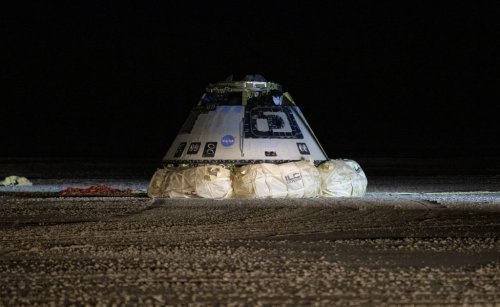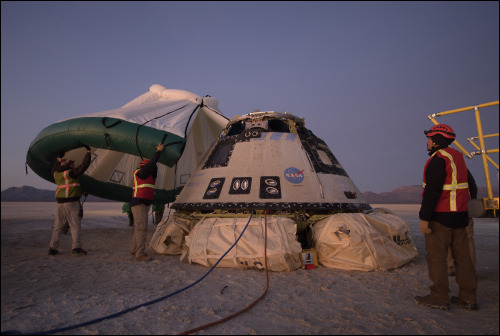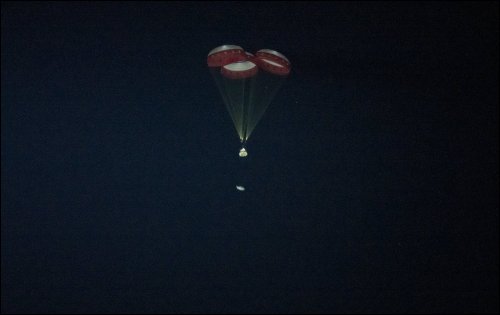Calypso Starliner returns to earth after shortened Orbital Flight Test (December 22, 2019). Followin
Calypso Starliner returns to earth after shortened Orbital Flight Test (December 22, 2019). Following a shortened, 49 hour, 21 minute flight in space, Boeing’s Starliner Calypso safely landed at the White Sands Space Harbor in New Mexico yesterday, December 22, 2019. A 55 second burn of the capsule’s Orbital Maneuvering and Attitude Control engines occurred at 7:23 am EST, with landing at White Sands 34 minutes later at 7:57 am. Ground and air-based images captured critical events in the capsule’s entry, descent and landing, including the successful deployment of all three drogue and main parachute canopies, heat shield jettison, and airbag deployment. Starliner’s November 4 pad abort test raised concerns when only two of the three parachutes unfurled, though Boeing stated that the capsule could land on two in an emergency without an additional risk to the crew. Recovery operations began once ground teams approached the capsule, installing an inflatable environmental shield and opening the spacecraft’s hatch. This marked the first time Boeing teams have practiced recovery operations on a space-flown capsule, and paves the way for procedures on future crewed flights.  Boeing recovery forces work to secure the Starliner Calypso after a successful landing at White Sands Space Harbor in New Mexico. Photo: NASA. NASA astronaut Suni Williams, who will command the same Starliner capsule that flew the OFT mission in late 2020, was given the honor by Boeing to name the returned capsule. She christened the spacecraft ‘Calypso’ after Oceanic explorer Jacques Cousteau’s famous ship. “A little homage to other explorers and the ships they rode on, I think we are going to call her ‘Calypso.’ Of course I love the ocean,“ said Williams, an avid diver as well as astronaut. “I love what the ocean means to this planet, we would not be this planet without the ocean. There is so much to discover in the ocean and there is so much to discover in space. It just seemed like a natural marriage.” Shortly after her statement, NASA Administrator Jim Bridenstein confirmed Williams’ choice, officially dubbing the capsule Calypso for the first operational Starliner mission, known as PCM-1. Calypso’s landing marks only the second time an orbital vehicle has landed at White Sands Space Harbor. The first was space shuttle Columbia following the STS-3 mission in 1982.  Boeing’s Starliner launches to orbit at 6:36am EST from SLC-41 at Cape Canaveral Space Force Station. Starliner lifted off from SLC-41 atop a ULA Atlas V N22 rocket at 6:36am EST Friday, December 20, from Cape Canaveral Space Force Station in Florida. The capsule was supposed to rendezvous with the International Space Station for a weeklong visit Saturday, but an 11-hour offset error in the Mission Event Timer caused an incorrect orbit to be achieved. This, in turn, depleted too much of Starliner’s fuel reserves, forcing NASA. and Boeing managers to call off the rendezvous. However, in a joint press conference Saturday between NASA and Boeing, managers stated that the remainder of the capsule’s systems were performing flawlessly and that most of the other test objectives of the OFT mission could be completed. Boeing will transport Calypso back to the Commercial Crew and Cargo Processing Facility at Kennedy Space Center within the next two weeks. Starliner will then undergo a thorough analysis of all its hardware to see the effects of orbital flight as well as to understand fully the root cause of the Mission Elapsed Timer anomaly. Boeing expects to have concluded this process by late spring next year, with the Crewed Fight Test to occur sometime over the summer. P/c: NASA. -- source link
#starliner#calypso#boeing#commercial crew#white sands



